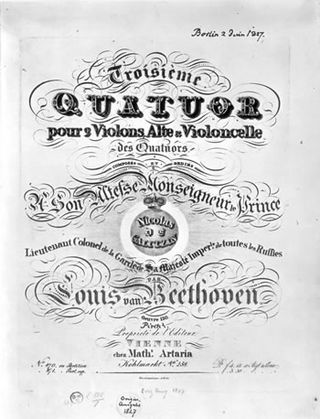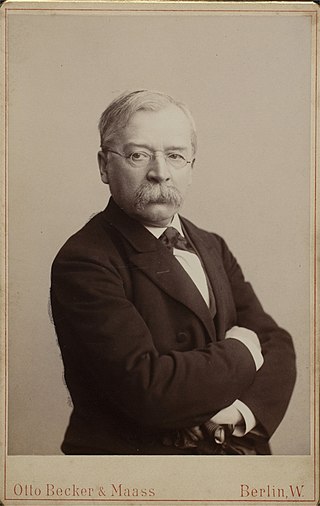Related Research Articles

The String Quartet No. 13 in B♭ major, Op. 130, by Ludwig van Beethoven was completed in November 1826. The number traditionally assigned to it is based on the order of its publication; it is actually Beethoven's 14th quartet in order of composition. It was premiered in March 1826 by the Schuppanzigh Quartet and dedicated to Nikolai Galitzin on its publication in 1827.

Ludwig van Beethoven completed his String Quartet No. 12 in E♭ major, Op. 127, in 1825. It is the first of his late quartets. Commissioned by Nicolas Galitzin over a year earlier, the work was not ready when it was scheduled to premiere. When it finally premiered by the Schuppanzigh Quartet, it was not well received. Only with subsequent performances by the Bohm Quartet and the Mayseder Quartet did it begin to gain public appreciation.

The String Quartet No. 9 in C major, Op. 59, No. 3, was written by Ludwig van Beethoven and published in 1808. This work is the third of three of his "Razumovsky" cycle of string quartets, and is a product of his "middle" period. It consists of four movements:

Woldemar Bargiel was a German composer and conductor of the Romantic period.
Sergei Prokofiev's Quintet in G minor, Op. 39 is a piece of chamber music for oboe, clarinet, violin, viola and double bass, written in 1924. The quintet, closely related to Prokofiev's ballet, Trapèze, contains six movements and lasts 20–25 minutes.
Antonín Dvořák composed his String Quartet No. 13 in G major, Op. 106,, between November 11 and December 9, 1895. 1895 was an eventful year for him: he returned to Europe from America in April, and his sister-in-law died in May. Upon finishing No. 13, he took back up his No. 14 (Op. 105) in A-flat major, which he had begun before this quartet and finished it on December 30 of that year. The quartet in G major was given its first performance by the Bohemian Quartet in Prague, on October 9, 1896.
Sergei Prokofiev's String Quartet No. 2 in F Major, Op. 92 (1941) was first performed by the Beethoven Quartet in Moscow on 7 April 1942. A later concert in Moscow, on 5 September 1942, was delayed by a Nazi air raid and started late. Prokofiev thought it "an extremely turbulent success." The string quartet, lasting for 20–25 minutes, is in three movements.
Hyacinthe Jadin was a French composer who came from a musical family. His uncle Georges Jadin was a composer in Versailles and Paris, along with his father Jean Jadin, who had played bassoon for the French Royal Orchestra. He was one of five musical brothers, the best known of whom was Louis-Emmanuel Jadin.
Sergei Prokofiev's Piano Sonata No. 7 in B♭ major, Op. 83 (1942) is a sonata composed for solo piano, the second of the three "War Sonatas". The sonata was first performed on 18 January 1943 in Moscow by Sviatoslav Richter. Performances of this sonata can last anywhere from 17 to about 20 minutes.

Sergei Prokofiev's Piano Sonata No. 8 in B♭ major, Op. 84 is a sonata for solo piano, the third and longest of the three "war sonatas", with performances typically lasting around 30 minutes. He completed it in 1944 and dedicated it to his partner Mira Mendelson, who later became his second wife. The sonata was first performed on 30 December 1944, in Moscow, by Emil Gilels.
The Op. 33 String Quartets were written by Joseph Haydn in the summer and Autumn of 1781 for the Viennese publisher Artaria. This set of string quartets has several nicknames, the most common of which is the "Russian" quartets, because Haydn dedicated the quartets to the Grand Duke Paul of Russia and many of the quartets were premiered on Christmas Day, 1781, at the Viennese apartment of the Duke's wife, the Grand Duchess Maria Feodorovna. The "Russian" quartets were some of Wolfgang Amadeus Mozart's favorite works by Haydn and in 1785 Mozart dedicated six string quartets to Haydn in admiration of the quartets.

Marie-Alexis de Castillon de Saint-Victor was a French composer.
Sergei Prokofiev's Piano Sonata No. 4 in C minor, Op. 29, subtitled D’après des vieux cahiers, or After Old Notebooks, was composed in 1917 and premiered on April 17 the next year by the composer himself in Petrograd. The work was dedicated to Prokofiev's late friend Maximilian Schmidthof, whose suicide in 1913 had shocked and saddened the composer.
The six string quartets, K. 155–160, were composed by Wolfgang Amadeus Mozart in late 1772 and early 1773 when Mozart was sixteen and seventeen years of age. Because they were composed in Milan while he was working on his opera Lucio Silla, they are popularly known as the Milanese Quartets. Before this set was composed, Mozart had written one earlier string quartet, so these six quartets are ordinally numbered from No. 2 to No. 7. The quartets are written in a plan of keys of D-G-C-F-B♭-E♭ following the circle of fifths.
The six string quartets, K. 168–173, were composed by Wolfgang Amadeus Mozart in late 1773 in Vienna. These are popularly known as the Viennese Quartets. Mozart may have hoped to have them published at the time, but they were published only posthumously by Johann André in 1801 as Mozart's Op. 94.
The Piano Sonata No. 9 in C major, Op. 103 by Sergei Prokofiev is his final completed piano sonata. It is dedicated to pianist Sviatoslav Richter.

Voces intimae, Op. 56, is a five-movement string quartet written in 1909 by the Finnish composer Jean Sibelius. He composed the work in D minor. It is the only major work for string quartet of his mature period.
References
- 1 2 Staff (15 November 2010). "Foundations for Music (Library of Congress Music, Theater, Dance: An Illustrated Guide)". Library of Congress . Retrieved 21 April 2012.
- 1 2 Sorensen, Sugi (2005). "The Prokofiev Page - String Quartet No 1 in B minor, Op 50". Allegro Media. Archived from the original on 4 February 2012. Retrieved 21 April 2012.
- ↑ Nice, David (2003). Prokofiev: From Russia to the West, 1891-1935. Yale University Press. Page 293.